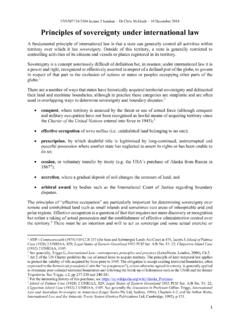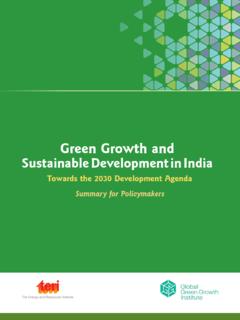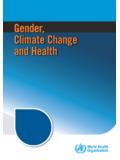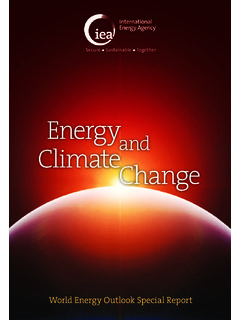Transcription of XSTRATA COAL QUEENSLAND PTY LTD (ACN 098 …
1 LAND COURT OF QUEENSLAND . REGISTRY: Brisbane NUMBERS: MRA092-11 & EPA093-11 (MLA 50229). MRA098-11 & EPA099-11 (MLA 50230). MRA105-11 & EPA106-11 (MLA 50231). Applicant: XSTRATA COAL QUEENSLAND PTY LTD. (ACN 098 156 702) and Others AND. Objectors: FRIENDS OF THE EARTH - BRISBANE CO-OP LTD. (QC0239 ) and Others AND. Statutory Party: DEPARTMENT OF ENVIRONMENT AND RESOURCE. MANAGEMENT. FRIENDS OF THE EARTH BRISBANE CO-OP LTD RESPONSE TO THE. APPLICANTS' REQUEST FOR PARTICULARS. 1. Paragraph 1(a) of the Applicants' Request for Further and Better Particulars ( the Request ) is not a proper request for particulars as it is a request for evidence and a response is not necessary to define the issues for trial or prevent surprise at the trial. 2. In respect of paragraph 1(b) of the Request, the ongoing climate change referred to in paragraph 20 of the facts and circumstances relied on in support of the grounds of objection ( the Objection ) are: (a) The facts, matters and circumstances stated in paragraphs 13-19 of the Objection.
2 (b) The climate system, because of its inertia, has not yet fully responded to the recent increase in human-made climate forcings ( factors that alter the balance of incoming and outgoing energy in the Earth-atmosphere system), of which the principal forcing is the increased concentration of carbon dioxide ( CO2 ). (c) The rise of mean global temperatures of approximately C observed between 1906 and 2007. (d) The current trend in mean global temperature rise of approximately C. per decade. (e) Observed decreases in annual average Arctic sea ice extent demonstrate that current level of atmospheric CO2 is already deleterious. Response to the Applicants' request for further and Solicitor: Sean Ryan better particulars Environmental Defenders Office Filed on behalf of Friends of the Earth Brisbane (Qld) Inc 30 Hardgrave Road, West End, 4101. Telephone: (07) 3211 4466. Facsimile: (07) 3211 4655. Email: 2. (f) Alpine glaciers are in near-global retreat, threatening the long-term water supplies of hundreds of millions of people using water from rivers originating in the Himalayas, Andes and Rocky Mountains, which suggest that the current level of atmospheric CO2 is already a threat.
3 (g) If atmospheric CO2 is stabilised at current levels, equilibrium sea level rise will still be significant judged from paleoclimate history. (h) Coral reefs are already impacted by warmer ocean temperatures and have experienced mass coral bleaching globally, which demonstrates that current level of atmospheric CO2 is already deleterious. 3. In respect of paragraph 2 of the Request, the facts, matters and circumstances relied on to contend that an initial 350 ppm carbon dioxide target may be achievable by phasing out coal use are: (a) The facts, matters and circumstances stated in paragraphs 17-20, 23, 33- 38 and 43-45 of the Objection. (b) Coal is the largest reservoir of conventional fossil fuels, exceeding combined reserves of oil and gas. (c) The only realistic way to sharply curtail CO2 emissions from human activities is to phase out coal use except where CO2 is captured and sequestered. (d) Phase-out of coal emissions by 2030 keeps maximum atmospheric concentrations of CO2 close to 400 parts per million ( ppm ), depending on oil and gas reserves and reserve growth.
4 (e) Even with phase-out of coal emissions by 2030, atmospheric CO2 would remain above 350 ppm for more than two centuries without human intervention to increase the natural rate of removal of carbon from the active carbon cycle. 4. In respect of paragraph 3 of the Request, the proved recoverable coal reserves in 2008 by area/region are approximately: Area/Region Total coal (Mt). Africa 31 692. North America 245 271. South America 12 508. Asia 228 264. Europe 265 027. Middle East 1 203. Oceania (mostly Australia) 76 973. TOTAL WORLD 860 938. These figures were reported by the World Energy Council ( WEC ) in the report entitled Survey of Energy Resources 2010 sourced from its member committees, data reported for previous WEC Surveys of Energy Resources and national and international published sources. 5. In respect of paragraph 4(a) of the Request, regarding the current trends in greenhouse gas emissions : 3. (a) The Objector repeats and relies on facts stated in paragraphs 17, 18, 46. and 47 of the Objection and further says that the average growth rate of anthropogenic greenhouse gas emissions is approximately billion tonnes of carbon dioxide equivalents ( CO2-eq ) per year (approximately 2% per year) over the period of 1995 to 2004.
5 (b) The above facts are calculated or worked out by reference to reports by the Intergovernmental Panel on Climate Change ( IPCC ), World Resources Institute, Australian Government, and Global Carbon Project. 6. In respect of paragraph 4(b) of the Request, regarding the current trends in temperature rises: (a) The Objector repeats and relies on facts stated in paragraphs 19, 22 and 23 of the Objection and further says that: (i) Mean global temperatures have risen by approximately C. between 1906 and 2007. (ii) Most of the observed increase over the 20th century is very likely ( >90%) due to anthropogenic emissions of greenhouse gases from the combustion of fossil fuels, agriculture, and land-use changes. (iii) The current trend in mean global temperature rise is approximately C per decade. (b) The above facts are calculated or worked out by reference to the report by the IPCC entitled Climate Change 2007. 7. In respect of paragraph 4(c) of the Request, the Objector repeats and relies on the facts, matters and circumstances stated in paragraphs 3, 5, 6, 7, 10, 11, 13-23, 27- 31, 33-38, 43-49 of the Objection and the further and better particulars of each of those paragraphs provided in this document and further says that: (a) Mean global temperatures are expected to rise to approximately 2 C above pre-Industrial levels if atmospheric concentrations of CO2 reach 450 ppm.
6 (b) The global emissions budget of CO2 ( the cumulative human CO2. emissions to stay below a certain warming level) if the mean rise of global temperatures is to be kept beneath 2 C is: (i) If cumulative human CO2 emissions are limited to approximately 890. billion tonnes over the period 2000 to 2050 there is a 20%. probability that mean global temperatures will exceed 2 C above pre-Industrial levels;. (ii) If cumulative human CO2 emissions are limited to approximately 1,000 billion tonnes over the period 2000 to 2050 there is a 25%. probability that mean global temperatures will exceed 2 C above pre-Industrial levels; and (iii) If cumulative human CO2 emissions are limited to approximately 1,440 billion tonnes over the period 2000 to 2050 there is a 50%. probability that mean global temperatures will exceed 2 C above pre-Industrial levels. 4. (c) cumulative human CO2 emissions over the period 2000 to 2010 were approximately 300 billion tonnes, leaving a global emissions budget between 2011 to 2050 of: (i) Approximately 590 billion tonnes of CO2 emissions remaining to give an 80% probability that mean global temperatures will not exceed 2 C above pre-Industrial levels.
7 (ii) Approximately 700 billion tonnes of CO2 emissions remaining to give a 75% probability that mean global temperatures will not exceed 2 C above pre-Industrial levels; and (iii) Approximately 1,140 billion tonnes of CO2 emissions remaining to give a 50% probability that mean global temperatures will not exceed 2 C above pre-Industrial levels. (d) If the proposed mine is allowed to proceed, the emission of approximately billion tonnes of CO2 from the mining and use of the coal from the mine would contribute approximately: (i) A 1/600th part of the cumulative human CO2 emissions remaining globally over the period 2011 to 2050 to give an 80% probability that mean global temperatures will not exceed 2 C above pre-Industrial levels;. (ii) A 1/700th part of the cumulative human CO2 emissions remaining globally over the period 2011 to 2050 to give an 75% probability that mean global temperatures will not exceed 2 C above pre-Industrial levels; and (iii) A 1/1140th part of the cumulative human CO2 emissions remaining globally over the period 2011 to 2050 to give a 50% probability that mean global temperatures will not exceed 2 C above pre-Industrial levels.
8 (e) For the reasons set out in paragraphs (a) to (d) above the contribution of the proposed mine to global warming is: (i) To increase the likelihood, severity and longevity global warming;. and (ii) A significant step towards mean global temperatures exceeding 2 C. above pre-Industrial levels. 8. In respect of paragraph 5 of the Request, the Objector repeats and relies on relies on the facts, matters and circumstances stated in paragraphs 13-23, 27-31, 33-38, 43-49 of the Objection, the further and better particulars of each of those paragraphs provided in this document in answer to the requests and further says that: (a) Regarding paragraph 24(a) of the Objection: (i) The precise nature and extent of each expectation in respect of the severe impacts on many ecosystems and human society in coming decades from rises in mean global temperatures due to anthropogenic global warming is set out in the IPCC report entitled 5. Climate Change 2007 and summarised in parts and of the Synthesis Report.
9 (ii) The facts matters and circumstances relied upon to demonstrate those expectations are set out in the IPCC report entitled Climate Change 2007;. (iii) The precise nature and extent of each impact on ecosystems and human society in coming decades from rises in mean global temperatures due to anthropogenic global warming is set out in the IPCC report entitled Climate Change 2007 and summarised in parts and of the Synthesis Report;. (iv) The facts matters and circumstances relied upon to demonstrate those impacts are set out in the IPCC report entitled Climate Change 2007;. (v) The facts matters and circumstances relied upon to demonstrate those impacts will be caused or contributed to by anthropogenic global warming, including the period and precise nature and extent, are set out in the IPCC report entitled Climate Change 2007;. (vi) The contribution of the proposed mine to these impacts and damages is proportionate to its contribution to global warming and ocean acidification set out in the Objection and these further particulars, particularly paragraphs 7 and 10 of this document.
10 (b) Regarding paragraph 24(b) of the Objection: (i) The expectations are that the impact due to global warming will lead to: (A) significant loss of biodiversity in the Great Barrier Reef;. (B) significant loss of biodiversity in the Wet Tropics;. (C) loss of tourism in QUEENSLAND consequent upon (A) and (B). above, leading to damage to QUEENSLAND 's economy and lowered employment in QUEENSLAND ;. (ii) The facts, matters and circumstance relied on to demonstrate the expectation of loss of biodiversity and tourism in the Great Barrier Reef are that: (A) Increased temperatures will exceed the thermal threshold of coral species in the Great Barrier Reef causing increased bleaching and mortality, leading to a loss of coral cover;. (B) Loss of coral cover will reduce the biodiversity of coral dependant species;. (C) Loss of coral cover will increase the prevalence of macroalgae and cyanobacteria, including those harmful to human health;. 6. (D) Loss of coral cover and dependant species, and increase in potentially harmful macroalgae and cyanobacteria will reduce tourism attracted by the Great Barrier Reef.








